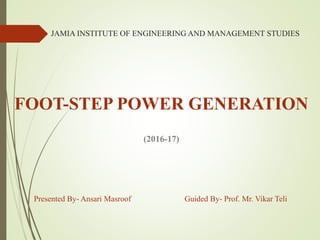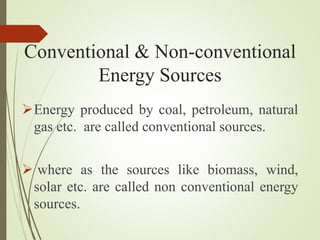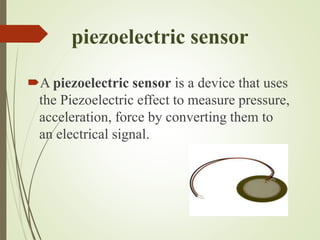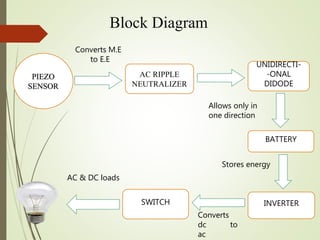Foot step power generation.ppt
- 1. JAMIA INSTITUTE OF ENGINEERING AND MANAGEMENT STUDIES FOOT-STEP POWER GENERATION (2016-17) Presented By- Ansari Masroof Guided By- Prof. Mr. Vikar Teli
- 3. CONTENTS  Introduction  Need of the system  Block Diagram  Working  Applications  Advantages & Disadvantages  Conclusion  Reference
- 4. INTRODUCTION  In this topic we are generating electrical power as non- conventional method by simply walking on footstep.  Walking is the most common activity in human life.  When a person walks, he loses energy to the road.  This energy can be tapped and converted in the usable form such as in electrical form.
- 5. History ï‚´ The piezoelectric effect was discovered in 1880, by two French physicists brothers Pierre and Paul. ï‚´ They took the name from the Greek word piezo, which means "to press."
- 6. Conventional & Non-conventional Energy Sources Energy produced by coal, petroleum, natural gas etc. are called conventional sources.  where as the sources like biomass, wind, solar etc. are called non conventional energy sources.
- 7. AN ALTERNATIVE ENERGY SOURCE  The Challenge – convert footstep energy to electrical energy.  The Solution – using piezoelectric material.
- 8. piezoelectric sensor ï‚´A piezoelectric sensor is a device that uses the Piezoelectric effect to measure pressure, acceleration, force by converting them to an electrical signal.
- 9. NEED OF THE SYSTEM  The utilization of waste energy of foot power with human motion is very important for highly populated countries.  India and China where the roads, railway stations, temples, etc. are all over crowded and millions of people move around the clock.
- 10. PIEZO SENSOR AC RIPPLE NEUTRALIZER UNIDIRECTI- -ONAL DIDODE BATTERY INVERTERSWITCH Converts M.E to E.E Allows only in one direction Stores energy Converts dc to ac AC & DC loads Block Diagram
- 11. WORKING When ever force is applied on piezo electric crystals that force is converted to Electrical energy is used to drive DC loads. And that minute voltage Which is stored in the Lead Acid battery.The battery is connected to the inverter. This inverter is used to convert the 12 Volt D.C to the 230 Volt A.C. This 230 Volt A.C voltage is used to activate the loads. We are using conventional battery charging unit also for giving supply to the circuitry.
- 12. APPLICATIONS Foot step generated power can be used for agricultural, home applications, street-lighting. Foot step power generation can be used in emergency power failure situations. Metros, Rural Applications etc.
- 13. ADVANTAGES Power generation is simply walking on step. No need fuel input. This is a Non-conventional system.  No moving parts - long service life.  Self-generating - no external power required. Compact yet highly sensitive
- 14. DISADVANTAGES Only applicable for the particular place. Initial cost of this arrangement is high. Output affected by temperature variation.
- 15. REAL-WORLD INSTALLATIONS  Simon School for Boys – UK  Empire State Building - US  Panduit Corporation World Headquarters – US  Riverdale Country School – US
- 16. CONCLUSION  Smart system  Produce 2000 watts of electricity.  Durable  Have a life of approx. 5 years.


















